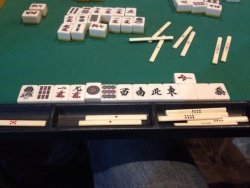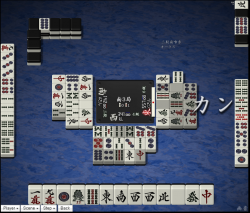Kokushi musou
| Type | Yakuman |
|---|---|
| Kanji |
国士無双 国士無双13面待ち |
| English | Thirteen orphans |
| Value | Yakuman (closed only) |
| Speed | Slow |
| Difficulty | Hard |
Kokushi musou 「国士無双」, kokushi for short, or thirteen orphans in English, is one of the standard yakuman hands. It is one of the two exceptions of the "four tile groups and one pair" requirement for winning hands, the other being chiitoitsu. Kokushi requires having 13 unique terminal/honor tiles, and a duplicate of any one of these tiles.
Composition
Kokushi musou requires one of each terminal tile from each suit, and one of each of the honor tiles. The 14th tile must be a duplicate of any terminal or honor tile. These tiles are classed as yaochuuhai 「幺九牌」. Because the hand does not contain tile groups, the hand must be closed.
If a player draws the thirteen different tile types before pairing any of them, then the hand is called kokushi musou juusan menmachi 「国士無双13面待ち」, or the kokushi musou 13 closed wait. Some rulesets count this type of hand as a double yakuman.
Tile diagram
The hand requires nothing but yaochuuhai.
Kokushi musou single wait
Kokushi musou 13-way wait
![]()
![]()
![]()
![]()
![]()
![]()
![]()
![]()
![]()
![]()
![]()
![]()
![]() Winning tile: Any one of the tiles shown here
Winning tile: Any one of the tiles shown here
- Winning from this wait may be worth two yakuman in some rules.
Meaning and usage
The word kokushi can be translated as "distinguished citizen"; the word musou is often translated as "peerless". The word kokushi should not split up and expressed as "Koku shimusou". This is an incorrect spelling.
Development
Kokushi is one of the three yakuman gosanke 「役満御三家」, or "the three big families of yakuman", along with suuankou and daisangen. These are the three most common yakuman, though still quite rare compared to regular yaku. Kokushi is the most common yakuman in 3-player, but in 4-player, it is overtaken by suuankou.
Restricted as closed only, this hand must draw at least 12 of the 13 required tile types. If a pair exists within the hand upon tenpai, then naturally, the hand is waiting on the last remaining tile type not yet in the hand. This hand will become impossible if all four of any of the tile types are no longer available.
Attempting kokushi

In order to for this hand to be reasonable, your starting hand should contain many terminals/honors, typically 9 or more. This gives the option to call kyuushu kyuuhai, if no tiles have been called by others, and if the ruleset allows this abortive draw. Declining (or not having) this option puts the hand on the path to form the yakuman.
| Hand | Yaochuhai start | Discard at tenpai | Result | Lobby | Link |
|---|---|---|---|---|---|
| 東 2 局 1 本場 | 9 | 9th | Ron after 12th | 上級 | [1] |
| 東 2 局 1 本場 | 9 | 6th | Ron after 6th | 7447 | [2] |
| 南 3 局 0 本場 | 10 | 4th | Ron after 5th | 鳳凰 | [3] |
| 南 1 局 2 本場 | 8 | 15th | Haitei ron | 特上 | [4] |
| 南 4 局 0 本場 | 7 | 11th | Ron after 12th | 上級 | [5] |
| 南 2 局 0 本場 | 11 | 2nd | Ron after 2nd | 7447 | [6] |
| 東 2 局 1 本場 | 9 | 6th | Tsumo on 8th | 鳳凰 | [7] |
| Yaochuhai start includes the initial draw. | |||||
Any player attempting kokushi musou makes the decision at the beginning of the hand. This will depend on a couple of conditions, the most important being the number of unique yaochuhai at the start. The point standing and the current round also matter. Sometimes, players need a yakuman in order to win or improve placement.
- At 9 or less unique yaochuhai, the chance of even reaching tenpai is quite low. Though the yakuman may be tempting, the expected value from attempting kokushi is lower than for a regular hand. Unless you really need a big hand, you should invoke a draw via kyuushu kyuuhai if able.
- At 10 unique yaochuhai, it becomes more reasonable to go for the yakuman. Once you have a pair, the hand's tile acceptance is somewhat lower than a 2-shanten chiitoitsu. This is decent when considering the value of a yakuman. Overall, the expected value from kokushi is greater than average, though the win rate is low, and 32000 points is often overkill. Therefore, if you need a quick hand (e.g., a tight point race when close to all last), invoking a draw is reasonable.
- At 11 unique yaochuhai, the hand is close to or already at iishanten, so you should usually go for kokushi.
Starting with a yaochuhai pair has little effect on success for 9 or 10 yaochuhai starts, only increasing the chance of reaching kokushi by a fraction of a percentage point. However, it substantially increases the chance of winning with a non-kokushi hand, mainly because of the chance for yakuhai.
If you are far ahead in the lead, then going for kokushi at 9 yaochuhai (or even less) can be considered. If it happens to succeed, you can possibly bankrupt a player and end the game. If it doesn't, then the tiles used to build kokushi are generally great for defense.
13-way wait development
Kokushi musou juusan menmachi is very rare. Out of all random tile draws that result in tenpai for kokushi, the chance of naturally drawing all 13 tiles without a single duplicate is approximately one in 9500 (~0.0106%). The only "consistent" way to achieve the double yakuman is to complete kokushi via tsumo, but discard the pair and hope to complete the hand while in furiten.
Discard characteristics
Kokushi has no use for tiles numbered 2-8, so those tiles will be discarded first. In particular, when middle tiles of all 3 suits are discarded early, then honor/terminal tiles are discarded from the hand afterwards, a player is likely aiming for kokushi.
Value
This hand is a yakuman hand. When dealer, the hand scores 48,000 points. For non-dealers, the hand scores 32,000.
Certain rulesets may grant a double yakuman for the 13-wait variety. Some allow the double yakuman no matter what; a few require that the 13-sided wait is not in furiten to score the double yakuman. The more common rule is to score the double yakuman no matter what.
Chankan rule variation

Under some rules, a kokushi tenpai hand may win via chankan off a closed kan made with the winning tile. When allowed, this is an exception to the usual rule that ron may be called off of the tile used to form an added kan, but not a closed kan. This rule, although not universal, is fairly common.
External links
- Kokushi musou in Japanese Wikipedia
- Osamuko.com entry on Kokushi
- Path of Houou blog
- 【麻雀】沢崎誠の国士無双13面張!! (YouTube)
- Kokushi 13, while furiten
| |||||||||||||||||||||||||||||||
| ||||||||||||||||||||||

